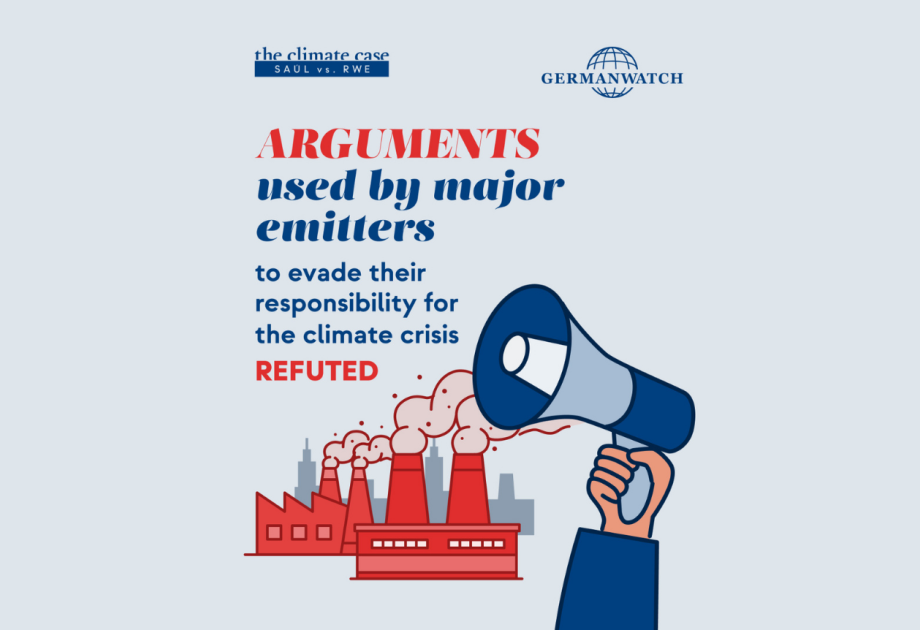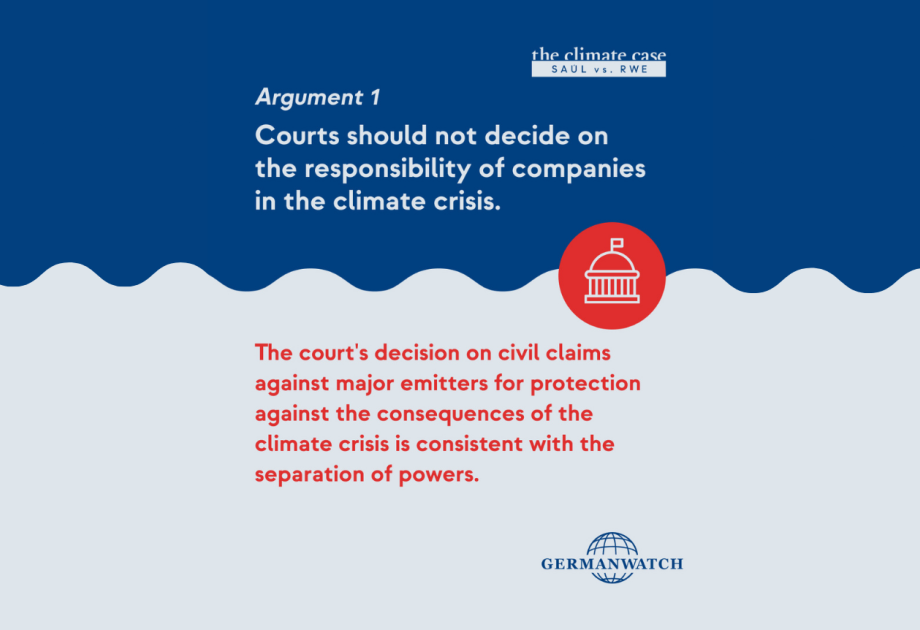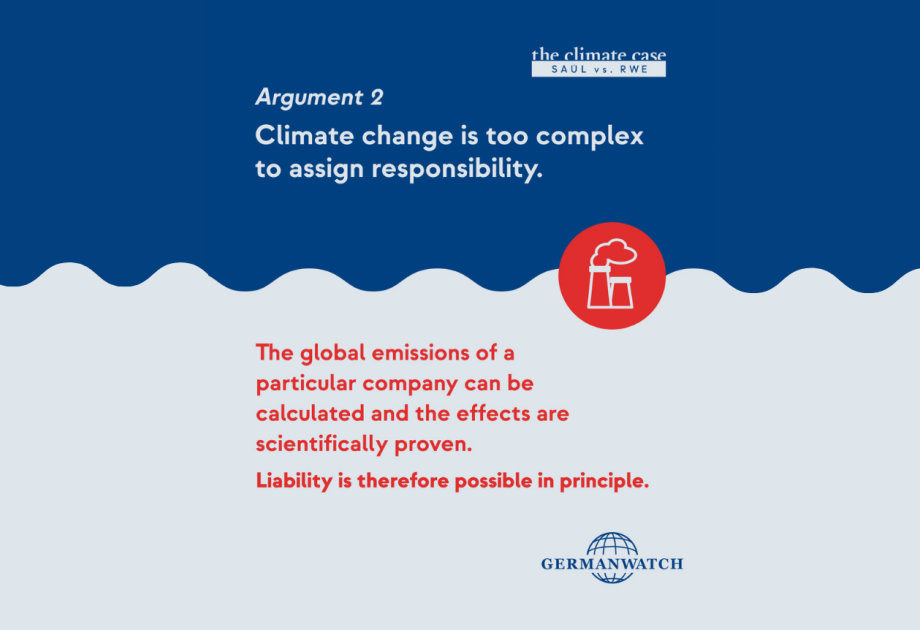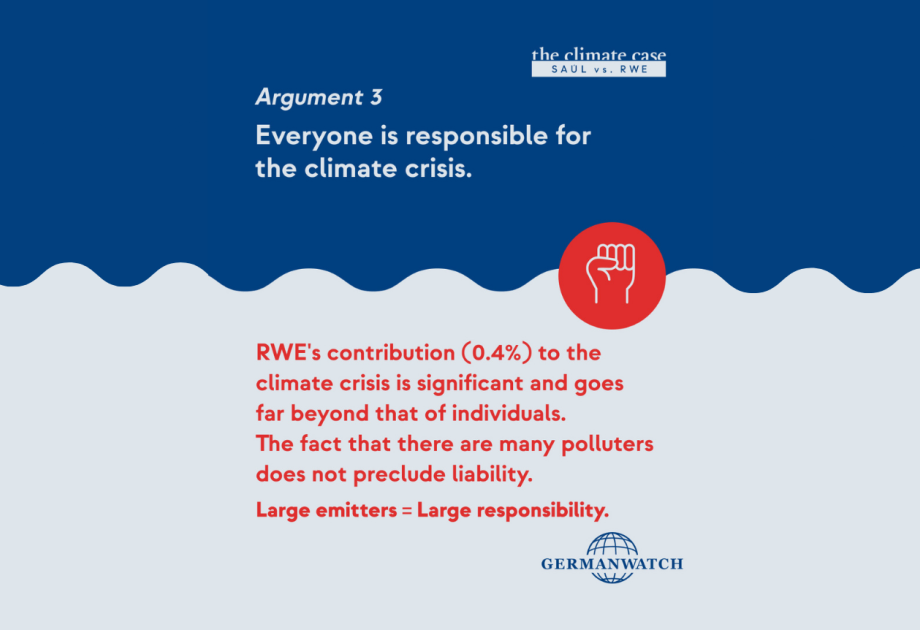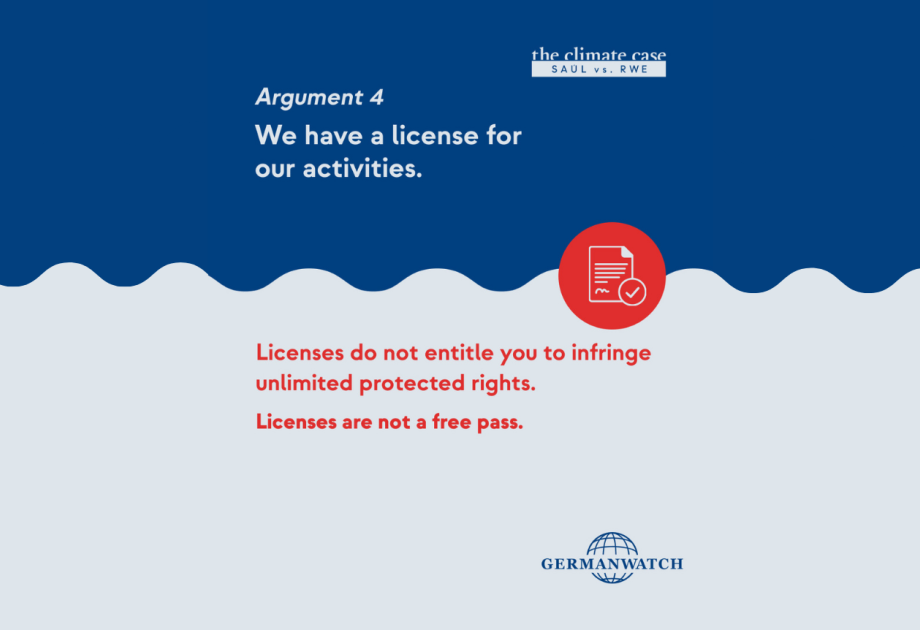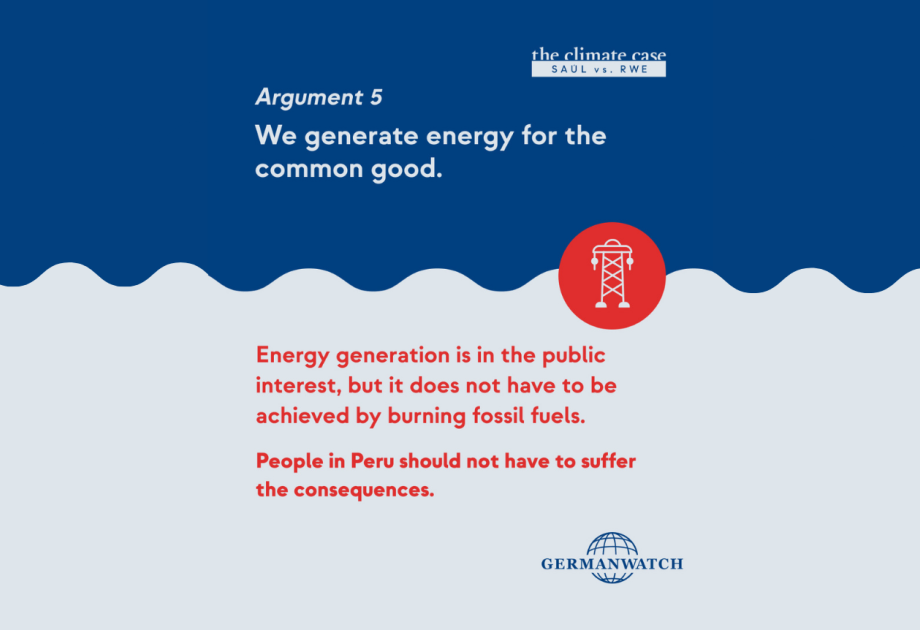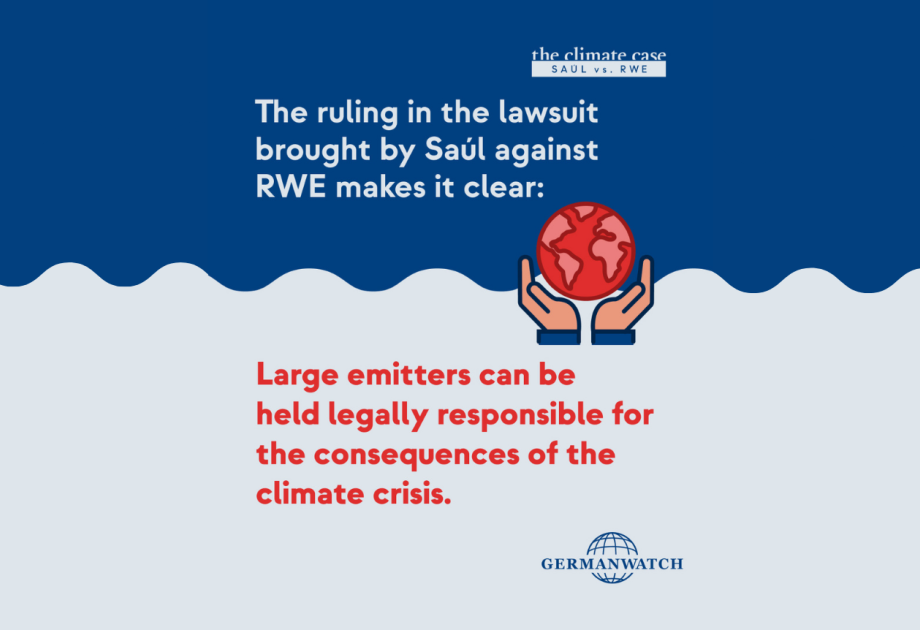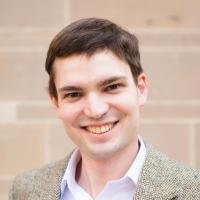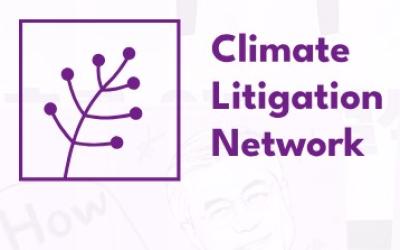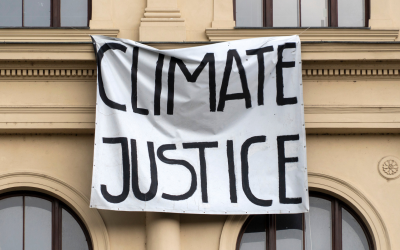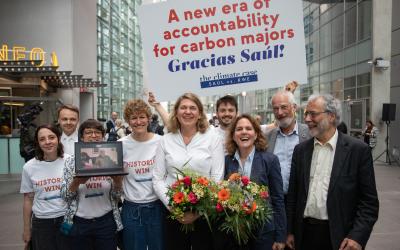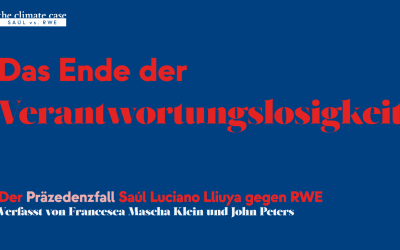

Legal
Historic ruling
On May 28, 2025 the Higher Regional Court of Hamm delivered its ruling on the civil case brought by Peruvian mountain guide Saúl Luciano Lliuya against German energy giant RWE. While the court dismissed Saul Luciano Lliuya’s claim, the decision nevertheless marked a significant success: the court sided with the plaintiff on the legal arguments.
For the first time in history, a higher court in Europe has ruled that large emitters can be held responsible for the consequences of their greenhouse gas emissions. German civil law is applicable in the context of the climate crisis.
Here you can find the full written judgement (unofficial translation).
The responsibility of major emitters for the climate crisis
A precedent-setting case
On November 24, 2015, Saúl Luciano Lliuya, a mountain guide and farmer, filed a lawsuit against the energy company RWE in a German civil court. His house is threatened by a flood wave from the rising glacial lake Palcacocha. The cause is climate change, which RWE is helping to cause through its business model. The lawsuit is the first time a person affected by climate change has demanded that one of the largest greenhouse gas emitters in Europe contribute to urgently needed protective measures. The indictment states: "Declare that the defendant is responsible to bear, in accordance with its proportionate share of the impairment amounting to 0.47%, costs for appropriate protective measures, insofar as these are carried out by the plaintiff or third persons, in order to protect the plaintiff’s property from a glacial flood from Lake Palcacocha, insofar as the plaintiff is burdened by these costs."
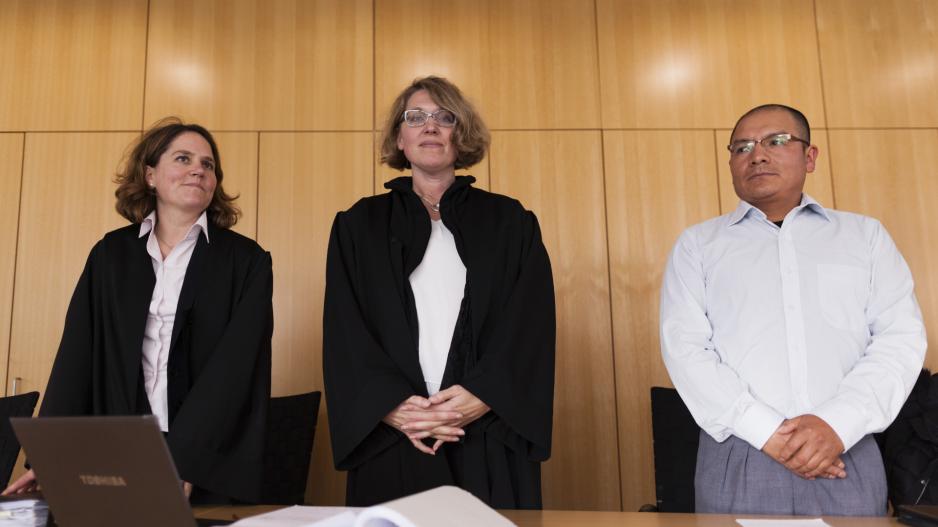
Saúl Luciano Lliuya with the lawyers Dr. Roda Verheyen and Clara Goldmann at the Higher Regional Court of Hamm on the climate lawsuit against RWE.
On November 30, 2017, the Higher Regional Court of Hamm (OLG) determined that it considered a civil claim based on the "neighborhood section" 1004 of the German Civil Code (BGB) against the energy company RWE to be possible in principle and decided to enter into the taking of evidence. With this decision, the court wrote legal history!
For the first time, a court has affirmed that, in principle, a private company is responsible for its share in causing climate-related damage. This applies if a share of concrete damage or risks to private individuals or their property can be attributed to the company's activities.
Such a precedent could also have financial implications for carbon majors. The Zero Carbon Analytics study examines the growing financial risks for companies arising from climate litigation and anticipates significant financial consequences for companies, including falling share prices, poorer credit ratings, and rising financing costs.
The Saúl v. RWE case has far-reaching implications beyond the specific legal dispute because it sends a strong signal: for the first time, a German civil court has confirmed that large CO₂ emitters can, in principle, be held liable for the consequences of their climate-damaging activities. This ruling is not only groundbreaking from a legal perspective, but also a strategic beacon—it shows other affected parties worldwide that going to court is a realistic option for claiming climate damages. By recognizing scientific attribution research—i.e., the link between emission shares and specific climate impacts—as valid, the court strengthens the basis for many other climate lawsuits. The ruling is particularly inspiring for vulnerable communities in the Global South: it shows that even distant polluters can be held accountable. At the same time, this precedent increases pressure on fossil fuel companies and reinforces the idea that civil courts are an effective tool for demanding climate justice – even across national borders.
Taking evidence
- Is there a serious threat of damage to Saúl Luciano Lliuya’s property?
- To what extent did climate change and CO2 emissions released by RWE contribute to this impairment
To answer the first question of evidence, the court arranged a site visit to Huaraz, which had to be postponed again and again due to the Corona pandemic. The on-site visit of a German court on the other side of the planet in Peru is extraordinary - perhaps even historic.
At the end of May 2022, the time had finally come! Judges of the Higher Regional Court (OLG) of Hamm, legal counsel and court-appointed experts traveled to Peru to investigate whether the house of the plaintiff and his family is actually threatened by a possible flood wave from the glacier lake Palcacocha, located 1,500 m above the city.
The experts submitted their written reportto the court and the parties in summer 2024. After that, the litigants had the possibility to respond to it. In March 2025 the hearing on the evidence took place.
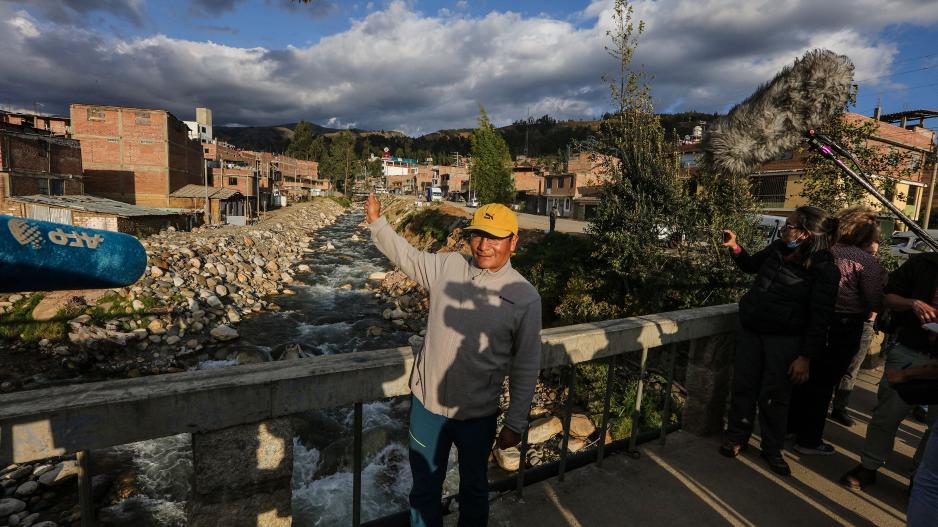
Saùl Luciano Lliuya during the on-site visit to Huaraz.
Timeline
What has happened so far?
24.11.2015: Saúl Luciano Lliuya files the lawsuit, which is classified as a „case of fundamental importance“ by the Essen Regional Court in December.
June 2016: In its defence, RWE denies its own responsibility for climate damage in the Andes and denies the flood risk.
15.12.2016: The Essen Regional Court dismissed the lawsuiton the grounds of a lack of "legal causality. Nevertheless, it conceded a possible "scientific causality".
26.01.2017: After the dismissive judgement in the first instance, Saúl Luciano Lliuya appeals to the Higher Regional Court of Hamm.
13.11.2017: At the oral hearing, the Court states that major emitters like RWE are in principle obliged to support people in poor countries affected by climate damages.
30.11.2017: The Higher Regional Court of Hamm decides to enter into the evidence phase and thus writes legal history. Extensive assessments are to be expected.
25.02.2018 and 14.03.2018: The Higher Regional Court of Hamm clearly rejects two counter-arguments by RWE‘s lawyers against the decision to take evidence and once again states that corporations can be hold accountable for climate change.
May 2022: Court visit in Huaraz.
August 2023: Court appointed expert delivers report on the 1st question of proof.
04.02.2025: Court sets dates for the hearing: 17th and 19th of March 2025.
17.03.2025 and 19.03.2025: The oral proceedings at the Higher Regional Court of Hamm took place and the plaintiff, Saúl Luciano Lliuya, travelled to Germany for this purpose.
28.05.2025: The Higher Regional Court of Hamm delivered its ruling in the legal proceedings of Saúl Luciano Lliuya against RWE.
§1004 - Global neighbourhood
Section 1004 of the German Civil Code, the general provision under German civil law for protection against interference with property, is the basis for the claim.
Paragraph 1: If the ownership is interfered with by means other than removal or retention of possession, the owner may require the disturber to remove the interference. If further interferences are to be feared, the owner may seek a prohibitory injunction.
Paragraph 2: The claim is excluded if the owner is obliged to tolerate the interference.
Many other jurisdictions have similar nuisance provisions as Section 1004. The RWE case not only increases pressure on emissions-intensive companies, but also on politicians to find viable long-term solutions.
The lawsuit builds on Section 1004 of the Civil Code, the basic nuisance provision under German law. The section is typically applied in neighbourhood disputes around issues of property impairment. It has been in force since 1900. In the 1899 explanatory memorandum to the law, the legislature pointed out that this norm can also regulate a legal relationship over broader distances. The Hamm Higher Regional Court found this to be relevant for the RWE case. It ruled that climate change with its cross-border effects has brought about a kind of global neighborly relationship, so that Section 1004 also applies here. In this case, it is about a 10,000 kilometers distance that separates RWE's headquarters in Essen from the plaintiff Saúl Luciano Lliuya in the Peruvian Andes.At a hearing, the judges commented that these are “prophetic phrases.”
“We live at the bottom of a sea of air. This circumstance necessarily means that human action extends into the distance... If the permission or prohibition of such an immission is to be determined, one must not only consider the relationship of neighbour to neighbour; rather, the scope of the owner’s right can be made to bear on all people... Someone who causes or spreads imponderabilia must know that these go their own way. Their propagation across the border can be attributed to them as a consequence of their action.”
The importance of climate science
This is the first case to authoritatively test attribution science in court. The court has accepted climate models as evidence in principle.
The RWE case has already made legal history. Companies like RWE can, in principle, be held liable for the consequences of their emissions if there is sufficient scientific evidence to prove causation. The court is now examining whether RWE can be linked to specific climate change impacts in the Peruvian Andes.
Tackling the complex evidentiary issues is a particular challenge for the court and expert witnesses as this is the only lawsuit of its kind to make it to an evidentiary hearing.
The case is a great challenge to science because we need to bring together different scientific disciplines, some of which still do not cooperate sufficiently. We need a more comprehensive understanding of human interactions on the climate system, ecosystems, and the feedback on society and its response.”, explains Prof Dr Christian Huggel, climate scientist.
An independent scientific study by researchers from the Universities of Oxford and Washington has already come to a clear conclusion: warming that is causing glacier melt in the region above Huaraz is more than 85 percent attributable to human emissions. In fact, they say it is more than 99 percent certain that the glacier retreat leading to the flooding risk at the glacial lake cannot be explained by natural changes alone.
This independent third-party study provides valuable evidence to show the causal chain between RWE emissions and climate change impacts in the Andes. In the future, more studies of this kind could enable similar lawsuits to hold other major greenhouse gas emitters accountable.
The RealClimate study also shows that tropical Andean glaciers are smaller today than at any time in the Holocene, i.e., for over 11,000 years. Isotope analyses of exposed rock have shown that many of these areas have been continuously glaciated since the beginning of human civilization—until now. The dramatic decline of the glaciers is directly linked to human-induced global warming and is also relevant to ongoing climate lawsuits such as the one brought by Saúl against RWE.
Contact persons
News
Aktuelles
Report: Ten Years of Climate Cases
This report charts the collective impact of ten years of climate litigation
since the Urgenda ruling and explores future directions for corporate and
governmental accountability.
It focuses on ‘framework’ climate litigation, also known as ‘systemic mitigation’
cases. Like the Urgenda case, these cases challenge a government or
company’s overall mitigation ambition.
Courts Are Shaping the Future of Climate Action
Amid rising geopolitical tensions, pressure to comply with climate obligations increasingly comes from courts. Earlier this year, both the International Court of Justice (ICJ) and the Inter-American Court of Human Rights (IACtHR) issued landmark advisory opinions affirming that countries must address climate change, and that failure to do so may carry serious legal consequences.
read moreClimate lawsuit Saúl vs RWE: “A historic ruling that can serve as a guide for courts around the world” – Interview
In principle, large emitters can be held accountable for climate risks. This was the ruling handed down by the Higher Regional Court on May 28 in the climate lawsuit brought by Saúl Luciano Lliuya against RWE. The court has thus made legal history. However, Saúl’s lawsuit was dismissed because the court did not consider the flood risk to his property to be sufficiently high. Francesca Mascha Klein, legal advisor for strategic litigation, has accompanied the proceedings and explains in this interview why the ruling is an important precedent.
read moreNew era of accountability
The ruling by the Hamm Higher Regional Court in the Lliuya v. RWE case has made legal history. For the first time, a German court has recognized that a company can be held liable under civil law for its contribution to the global climate crisis - even across national borders. Here you can read all the important legal points from the judgment of May 28, 2025.
read more